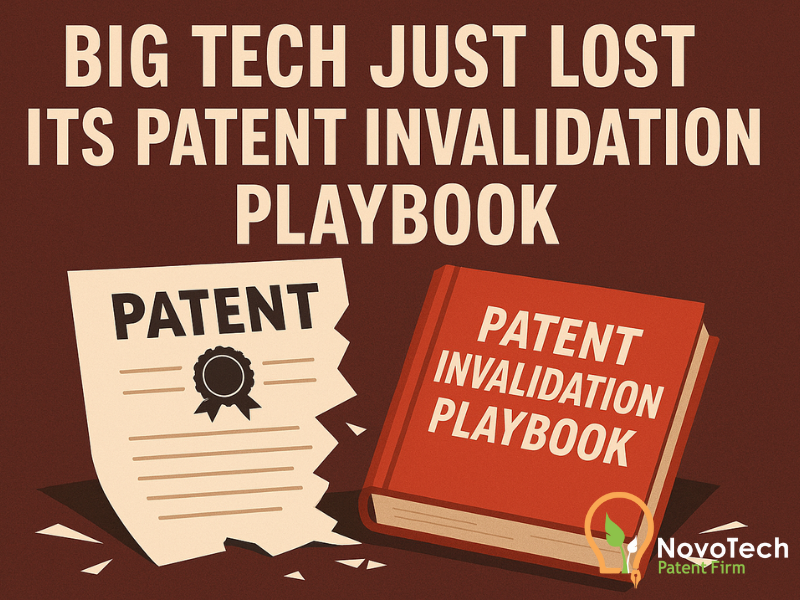
Big Tech Faces Losing Its Patent Invalidation Playbook
Authored by Babak Akhlaghi on October 17, 2025. The numbers tell a story the USPTO finally decided to acknowledge. More than half of all IPR petitions since the America Invents Act target patents already under challenge.
That’s not quality control. It reflects systemic incentives that have shaped patent challenges.
I’ve watched this pattern emerge over years of practice. The math is brutal for patent holders. Even if 70% of patent attorneys believe a patent was properly issued, subjecting it to multiple IPR rounds pushes invalidation probability above 50%, as the USPTO proposed rulemaking notice points out.
Over time, the odds have favored challengers under the current framework.
The Economics of Patent Warfare
Here’s the calculation big tech companies have been running. An IPR challenge costs around $250,000. A licensing deal with a patent holder? Potentially millions.
For large technology companies, filing multiple IPRs has been cost-effective strategy compared to licensing. Larger companies have resources to sustain prolonged legal strategies, while smaller firms often resource constraints.
The system created asymmetric warfare. Patent holders face double jeopardy, defending in IPR proceedings and district court simultaneously. About 80% of IPR cases involve parallel litigation.
But there’s a critical difference in those venues.
In district court, patents enjoy presumption of validity. The burden of proof is clear and convincing evidence. In IPR, you’re re-opening the original examination with preponderance of evidence and no presumption of validity.
Same patent. Two completely different standards. The IPR path offers challengers a structural advantage they’ve exploited relentlessly.
The Investment Chill Nobody Talks About
When patents become unreliable, venture capital dries up. I’ve seen startups with disruptive innovations and solid patent portfolios struggle to attract investment.
The logic is straightforward. Young companies can have 90% of their value tied to intellectual property. If that IP faces endless challenges with a 70% all-claims invalidation rate, the investment becomes a coin flip.
VCs know the patent will likely face expensive serial challenges. They know it probably won’t survive. Their capital stays on the sidelines.
Small companies don’t have market reach or massive budgets. Patents are their only tool to keep bigger corporations at bay. Remove that shield, and they don’t stand a chance.
The Overnight Value Shift
The USPTO’s proposed rule flips this entire dynamic. Challengers get one shot at the apple.
If an IPR is instituted, petitioners must stipulate they won’t challenge patentability in another forum under novelty or non-obviousness grounds. If a patent survives any prior proceeding, subsequent IPRs won’t be instituted.
No more serial challenges. No more parallel forum shopping.
This represents a fundamental shift in what patents mean as business assets. They’re becoming real shields again, not just paper that can be challenged into oblivion by whoever has more money and patience.
The rule is still proposed, not final. But I expect it will go through. The notice aligns with broader administrative initiatives strengthening patent rights. We’ve seen increased discretionary denials of IPR, reminders that AI innovations are patent eligible, terminations without final written decision.
This isn’t happening in isolation.
What Changes Now
For startups, my advice stays consistent. Protect your inventions before you disclose them. But now those patents carry real weight in funding conversations.
For established players who’ve relied on IPR to challenge asserted patents, the strategy shifts dramatically. Provide all your defenses in your first filing. There won’t be a second chance.
The competitive dynamic changes most in sectors where R&D investment is massive. Biotech companies with breakthrough therapies can negotiate licensing deals from strength rather than constantly defending against serial challenges. Software and hardware startups in AI can secure funding without the threat of being bled dry by IPR proceedings.
The proposed rule would limit the ability to pursue multiple filings, encouraging all parties to consolidated their arguments upfront. They’ll have to compete on innovation or pay fair licensing fees.
The patent system is getting a market correction. Patents are becoming critical economic tools for competition again, not just technical legal rights that dissolve under repeated attack.
The comment period closes in 30 days. If you’re a stakeholder in patents, now is the time to act before this gains more traction.
Stay Informed with Expert Insights!
Want more valuable tips on navigating patent law and protecting your intellectual property? Join our free weekly newsletter for the latest updates, expert advice, and exclusive content straight to your inbox. Subscribe today and never miss out on essential information that can make all the difference in your patent journey! Subscribe to our Newsletter